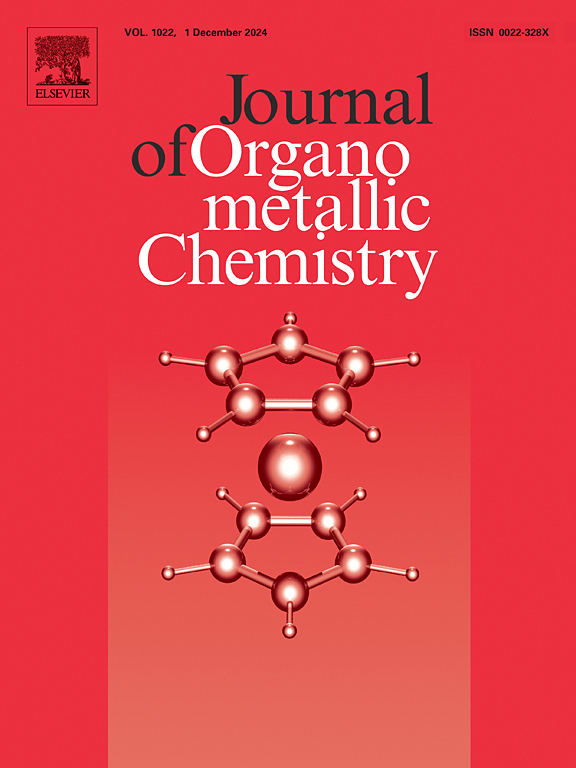Design and fabrication of chitosan functionalized magnetic composite anchored Ru nanoparticles as a sustainable organometallic nanocatalyst for Suzuki-Miyaura coupling
IF 2.1
3区 化学
Q3 CHEMISTRY, INORGANIC & NUCLEAR
引用次数: 0
Abstract
In this research, a magnetic nanocatalyst referred to as Fe3O4/Si@CS-Ru NPs was created through the initial formation of Fe3O4 nanoparticles coated by silica layers, followed by the modification of the surface with chitosan, and concluding with the incorporation of Ru nanoparticles as the active catalytic elements. The resulting structure delivers a durable, magnetically recyclable nanocomposite with exceptional catalytic performance. Advanced characterization techniques, including SEM, TEM, EDX, EDX-Mapping, VSM, and ICP-OES, were applied to validate the properties and chemical structure of the nanocatalyst. The developed nanocatalyst was applied in the Suzuki-Miyaura coupling to create C–C bonds. The Fe3O4/Si@CS-Ru NPs displayed a high level of catalytic efficiency, showing excellent results with a range of aromatic halides. Additionally, the catalyst shown impressive magnetic recyclability, maintaining its efficacy even after 7 reaction cycles. A hot filtration experiment confirmed the heterogeneous nature of the catalyst, as no leaching was detected throughout the reaction procedure.

壳聚糖功能化磁性复合锚定钌纳米颗粒作为铃木-宫浦偶联可持续有机金属纳米催化剂的设计与制备
本研究首先将Fe3O4纳米颗粒包被二氧化硅层,然后用壳聚糖对其表面进行修饰,最后加入Ru纳米颗粒作为活性催化元素,制备了Fe3O4/Si@CS-Ru NPs磁性纳米催化剂。由此产生的结构提供了一种耐用的、磁性可回收的纳米复合材料,具有卓越的催化性能。采用SEM、TEM、EDX、EDX- mapping、VSM和ICP-OES等先进表征技术对纳米催化剂的性质和化学结构进行了验证。将所研制的纳米催化剂应用于Suzuki-Miyaura偶联中生成C-C键。Fe3O4/Si@CS-Ru NPs表现出较高的催化效率,对一系列芳香族卤化物表现出优异的催化效果。此外,该催化剂表现出令人印象深刻的磁性可回收性,即使在7个反应周期后仍保持其功效。热过滤实验证实了催化剂的非均相性质,因为在整个反应过程中没有检测到浸出。
本文章由计算机程序翻译,如有差异,请以英文原文为准。
求助全文
约1分钟内获得全文
求助全文
来源期刊

Journal of Organometallic Chemistry
化学-无机化学与核化学
CiteScore
4.40
自引率
8.70%
发文量
221
审稿时长
36 days
期刊介绍:
The Journal of Organometallic Chemistry targets original papers dealing with theoretical aspects, structural chemistry, synthesis, physical and chemical properties (including reaction mechanisms), and practical applications of organometallic compounds.
Organometallic compounds are defined as compounds that contain metal - carbon bonds. The term metal includes all alkali and alkaline earth metals, all transition metals and the lanthanides and actinides in the Periodic Table. Metalloids including the elements in Group 13 and the heavier members of the Groups 14 - 16 are also included. The term chemistry includes syntheses, characterizations and reaction chemistry of all such compounds. Research reports based on use of organometallic complexes in bioorganometallic chemistry, medicine, material sciences, homogeneous catalysis and energy conversion are also welcome.
The scope of the journal has been enlarged to encompass important research on organometallic complexes in bioorganometallic chemistry and material sciences, and of heavier main group elements in organometallic chemistry. The journal also publishes review articles, short communications and notes.
 求助内容:
求助内容: 应助结果提醒方式:
应助结果提醒方式:


